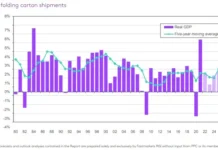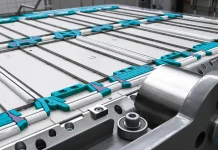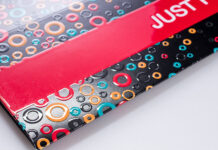by: Trish Witkowski, Finishing Experts Group, Inc.
Just about every step in the print production process has been modernized – but the one real holdout is folding. Yes, programmable folding machinery has been around for several years, and there are automated folding systems that can do incredible things. However, until folding itself goes digital, automation alone will not be enough to truly maximize production efficiencies.
Now, I want to be clear – I’m reaching for the stars here. We’re talking about the Holy Grail of print production – end-to-end total process automation. In my opinion, it’s an attainable goal, but we have work to do to get there. Before we get started, if by some chance you aren’t convinced that we even need to “go there,” here are a few compelling reasons to aggressively pursue total process automation for folded materials.
- Demand for “lights-out” automation is growing with the steady increase in digital short run printing, web-to-print, and print-on-demand business models. The technology exists to achieve this goal. However, implementing a fully automated end-to-end workflow is not a plug-and-play endeavor.
- Shorter run lengths and faster turnaround times require frequent makereadies, so manual tasks waste a lot of time that we don’t have. Build in the likelihood of human error, and things can get backed up, costly, and off schedule very quickly.
- There is a growing need to automate folding because skilled bindery operators are getting harder to find – folding as an “art” has become a thing of the past as a generation of trained bindery experts is slowly phasing out of the industry.
- A downturn in the economy, the commoditization of print, international competition, and pricing pressures demand a more efficient and cost-effective process.
- Fold placement is math, and because of this, standardizing the file set-up process for folded material is a real possibility. We cannot automate a process that has not been standardized, and therefore without a standardized file submission process for folded materials, we cannot even hope for total process automation.
Assessing the Scenario
Turning folding into the streamlined, standardized, computerized process it should be is a fairly ambitious task. Here’s the problem as it stands:
- Currently, there is absolutely no control over the digital document creation process. A printer basically has to work with whatever file he gets from a client. And since file set-up for folding can be a fairly complex task, who knows what you’ll actually get from the client, and how long it will take the print provider to fix the file. Thats problem number one.
- Problem number two is that once you have a press-ready file, and that file can be sent through to the MIS system as a PDF in a digital workflow, that file does not currently carry the information necessary to communicate with the system to tell it what the folding style is, the placement of the folds, etc. which leads to problem number three.
- Even if the folding machinery is a whiz-bang programmable JDF-compliant monster, it will still require some degree of manual adjustment because the file does not hold JDF folding intent information. Without the JDF data, the MIS cannot send precise settings to the automated folding machine. The file stops at the bindery and waits for (fancy, motorized) machine set-up.
Looking at the problems laid out above, the path to fully automated folding can be boiled down to two major issues – the need to control the file submission process upstream at the design stage, and the need to embed JDF folding intent into the file to enable communication downstream to finishing.
Assessing Current Technologies
Let’s take a look at existing technologies as they relate to the two major issues we’ve identified:
JDF folding intent – There have been dramatic improvements in the folding section of the latest iteration of the JDF specification. Previously, there was a library of set folding styles, which really limited the scope of JDF for folding. Folding is varied and broad in its spectrum, so a more flexible solution is required to accommodate for this. The JDF 1.4 specification has expanded to not only offer the standard set of folding styles from the previous version, but also offers the ability to define your own folding settings. This is a huge step forward.
Control over the file submission process – By now, we’ve realized that there will never be a day when all designers understand how to manually set up a file correctly for a folded product. As a matter of fact, we won’t see a day when 20 percent of all designers do it right. It’s not their fault – file set-up for folding is a precise process that is not currently taught in any graphic arts program anywhere, and manual file set-up (by the designer or print production person) almost welcomes human error. With that said, the only viable solution is through widespread use of custom automated folding templates.
The template is critical, since it virtually eliminates human error, and offers a file that is set up precisely for the folded process – the designer can just start designing. However, the file also must accomplish another goal: it must carry JDF folding intent, and this data must be populated at document creation. There must be no manual data entry, and it must work in the background. Designers do not know, nor do they care to know, anything about JDF. If we can embed it in the file under the hood, the file can talk, and we can understand it.
A Call to Action
For folding to truly go digital, making way for “lights-out” automation, it will take an aggressive, industry-wide push to make it happen. Collaboration is key, the tools are sitting in our laps, and the time is right.
Trish Witkowski is the president of Finishing Experts Group, Inc. She is the creator of the FOLDRite™ software system, a 2004 GATF InterTech™ Technology Award winner that builds dynamic custom digital templates that are mathematically adjusted for the folding process. These templates also have been proven to populate and embed JDF folding intent, standardizing the file submission process for folded materials. Witkowski holds a bachelor of fine arts degree in graphic design and a master of science degree in graphic arts publishing from Rochester Institute of Technology’s School of Printing Management and Sciences (now the School of Print Media). Current publications include: A Field Guide to Folding, Folding for the Graphic Arts: A Teacher’s Handbook, and FOLD: The Professional’s Guide to Folding. For these publications, and for custom digital folding templates, videos, and more, visit her online folding community at www.foldfactory.com. For more information, email trish@foldfactory.com.
CASE STUDY: JDF Works! Print Shop Live, Graph Expo 2008
At Graph Expo this past October, FOLDRite participated in the first-ever end-to-end live JDF workflow collaboration at a show between multiple vendors. Other participants included Adobe, Avanti, Kodak, Xerox, Duplo, EFI, Canon, Heidelberg, and CIP4.
The product produced was a folded brochure, created with a FOLDRite template in Adobe InDesign. The challenge was figuring out how to embed custom XMP data tags into the Adobe InDesign template that was generated. These tags would indicate fold placement and would communicate this information downstream to the automated folding machine. The brochure layout was exported as a PDF, and the XMP data stayed with the file. JDF data also was built in from the other vendors by request, including trim, etc. There was a web portal to upload the PDF, and upon upload it exported a JDF file that could then be absorbed by the MIS system. After that, it was up to the MIS system to communicate the information to the workflow software, the digital color printer, and ultimately to send the folding intent and related information to the automated folding machine.
How did we do it? There was a lot of back-and-forth in building and testing the JDF file, since different systems process JDF differently, so a lot of adjustments were made to make the file palatable for all systems. Valid JDF files were passed back and forth, but just because the file is technically correct does not mean that it works on all machines. Further testing was provided with files to support this process and collaborate across the workflow requirements for communicating the job intent and job messaging.
The end result was a success. The collaboration demonstrated that it was possible to embed JDF data into a custom digital folding template and to pass the data through the entire workflow to ultimately control the set-up of an automated Duplo cutter/slitter/creaser machine for end-to-end automation.




